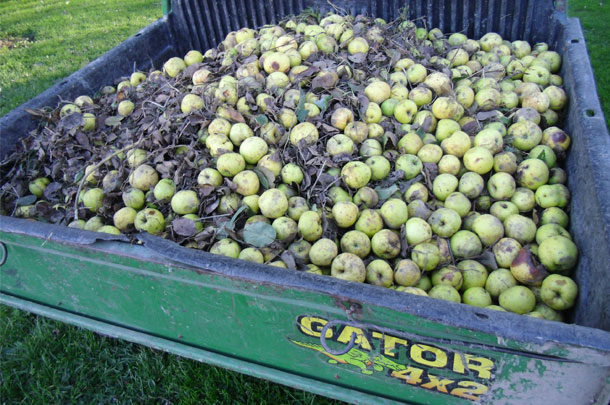Grazing cattle and horses, as well as moose, elk, deer, goats and sheep, are guilty of overindulging in the sugary bounties of Mother Nature (or via the assistance of a few too many cans of beer provided by their well-intended owners). Many a passerby in my hometown encountered my dad’s beer guzzling, not-so-miniature pig, named Boar-was, blocking the road. I am sure he was responsible for at least one vehicular accident. But while the occasional drunken pig (or moose, as is commonly the case in one Swedish village) tottering around is hilarious, it is quite another thing to have an entire herd drunk from binging on fermented apples.
A local writer and former neighbor of mine, Pat Davis, tells a story of the day “six highly inebriated cows, marching flank to flank like a row of members of a marching band, came charging down over a bank, bawling at the top of their lungs, stopping just short of a fence and together whirling around as one giant fan, charged back up over the hill.”
Or, as another farmer shared with me, how about the fella whose entire dairy herd was found falling-down drunk from imbibing on the juices coming off a recently filled silo that had drained into the barnyard? His entire herd, ready to be milked, was unable to stand up in their stanchions until the following day!
In a year like this, when apple trees exist in pastures and apples are abundant, acidosis is a real concern. Trust me – it’s not always a laughing matter. It can also occur when animals are turned out to clean up a field of sugar beets, potatoes or a windblown field of immature wheat, barley or corn. I will summarize from personal experience and from my Merck Veterinary Manual the clinical findings associated with drunken cows. You can also read about these symptoms online.
For pasture producers, knowing the quantity of apples available is a good starting point. The disposition of your herd is also a key factor. I had just weaned this year’s fall calf crop and locked the cows into a pasture they had not grazed since May. After assessing one paddock that had just one apple tree of concern, I decided it was safe to turn out the cows. Assuming they would all eat their fair share? To my dismay, only the first-calf heifers, disinterested in their bawling dependent, headed to the apple tree while the older cows stayed up by the barn lulling to their entrapped offspring. Suddenly, what had looked like just a few apples for an entire herd seemed ill-advised for a few young mothers. (If you did not know, a single tree can yield 70 to 130 pounds of apples – significantly more than the 20 to 30 pounds of starch a moderately fleshed pastured animal might be able to tolerate.)
Despite my best effort, I could not chase those heifers away from that tree! My only recourse was to go get the other cows – a dance I am sure you can appreciate visually. After assessing the quantity of shed apples on the ground in the next pasture, I decided we would have to shovel them up before letting the herd graze it.
Perhaps I was being over cautious, but acidosis in cattle can be lethal within two to six hours. According to the Merck Veterinary Manual, it can progress to lethal levels of BAC, “cardiovascular collapse, renal failure, muscular weakness, shock, and/or death. Animals that survive may develop mycotic rumenitis in several days and hepatic abscesses several weeks or months later.”

Acidosis also increases lameness. While we are more familiar with this problem in feedlots, many of us have also seen the feet of donkeys and horses that foundered from grain overload. In hindsight, multiple horizontal lines that appear as the hoof wall grows out are a good indication grain overload occurred in the past.
Moderately incapacitated animals may lie down, stagger, go off feed, show signs of abdominal pain and have diarrhea. Engorgement on water may occur at this stage due to dehydration, which in itself can cause further complications. A good indicator that a fatal overload has been ingested is when the cow’s heart rate exceeds 120 beats per minute. Any feces exuded at this point have a distinctively sweet odor. Undigested grain particles are common at any stage.
While withholding water for the first 18 to 24 hours is advised, it’s not always going to help, especially if the animal is already severely dehydrated. In less severe cases, administration of magnesium hydroxide might improve rumen function. However, during the recovery stage of two to four days, relapses are possible, and slaughter is then advised – quite an expensive outcome if multiple cattle are affected.
When you can, avoid exposing your cattle to situations that favor starch overload. FG
Melissa Bravo is a certified crop adviser and herd health specialist with Meadow Lake Farm Consulting. Email Melissa Bravo.
PHOTO 1: To prevent acidosis in cows grazing a pasture that contained an apple tree, we had to scoop up and remove the bulk of the apples that had fallen to the ground.
PHOTO 2: The rings in this hoof from a performance-tested bull indicate grain overload. Photos by Melissa Bravo.








